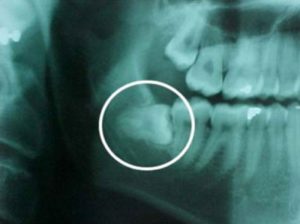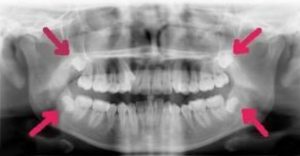Dr. Kilby may recommend extracting a tooth if:
- Your tooth is too damaged by a fracture or deep cavity to repair.
- You have a sizable infection that cannot be resolved by a root canal alone.
- You have teeth that are blocking other teeth from coming in. These may be extra teeth or baby teeth that have not fallen out yet.
- You are getting braces and need to get rid of a tooth that is crowding others.
Wisdom teeth, which typically come in during your teens or twenties, may need to be extracted if they are decayed, infected, or causing pain. They may get impacted—stuck underneath other teeth—which also requires extraction.
Common Causes of Toothache
- Cracked tooth
- Dental filling, especially if deep or damaged
- Tooth decay
- Nerve damage to teeth
- Dental sensitivity
- Gum disease and infections
- Impacted wisdom teeth
- Sinusitis
- Jaw problems (TMJ)
- Toothache after dental treatment

 Most visible teeth can be removed with a simple extraction, where Dr. Kilby loosens the tooth, then removes it carefully with forceps. This procedure typically requires just a local anesthetic.
Most visible teeth can be removed with a simple extraction, where Dr. Kilby loosens the tooth, then removes it carefully with forceps. This procedure typically requires just a local anesthetic.
Directly after the extraction, you’ll be asked to keep gauze on the extraction site to help the blood clot. It’s important to protect this clot as the wound heals. Eat soft foods, and don’t smoke, use a straw or spit, as these actions can dislodge the clot.
Most people feel some discomfort after having a tooth extracted. You can take non-steroidal anti-inflammatory drugs (NSAIDs) like ibuprofen to help relieve the pain. Dr. Kilby will recommend the dosage that’s right for you.
You can also use icepacks to decrease any swelling. If your jaw is still stiff after any swelling has subsided, try warm compresses. In general, swelling and bleeding last only a day or two after the extraction, and any pain should go away after a few days.
A surgical extraction may be needed if:
- The tooth has broken off at the gum line.
- The tooth hasn’t come in yet (wisdom teeth, for example)
- The tooth has especially large or curved roots
 During a surgical extraction, most patients are able to have the procedure completed with local anesthetic only. However, if you feel anxiety about the procedure, Dr. Kilby may be able to prescribe an oral anti-anxiety medication to help you cope with your procedure. The procedure is virtually painless. You might feel pressure or pulling, but no pain. Directly after the extraction, you’ll be asked to keep gauze on the extraction site to help the blood clot. It’s important to protect this clot as the wound heals. Eat soft foods, and don’t smoke, use a straw or spit, as these actions can dislodge the clot.
During a surgical extraction, most patients are able to have the procedure completed with local anesthetic only. However, if you feel anxiety about the procedure, Dr. Kilby may be able to prescribe an oral anti-anxiety medication to help you cope with your procedure. The procedure is virtually painless. You might feel pressure or pulling, but no pain. Directly after the extraction, you’ll be asked to keep gauze on the extraction site to help the blood clot. It’s important to protect this clot as the wound heals. Eat soft foods, and don’t smoke, use a straw or spit, as these actions can dislodge the clot.
Most people feel some discomfort after having a tooth extracted. You can take non-steroidal anti-inflammatory drugs (NSAIDs) like ibuprofen to help relieve the pain. Dr. Kilby will recommend the dosage that’s right for you. Further, Dr. Kilby may prescribe other medications if necessary.
You can also use icepacks to decrease any swelling. If your jaw is still stiff after any swelling has subsided, try warm compresses.
In general, bleeding last only a day or two after the extraction, swelling may last for one to three days, and any pain should go away after a few days.
 By the age of eighteen, the average adult has 32 teeth; 16 teeth on the top and 16 teeth on the bottom. The average mouth is made to hold only 28 teeth. It can be painful when 32 teeth try to fit in a mouth that holds only 28 teeth. These four other teeth are your Third Molars, also known as "wisdom teeth”. Wisdom teeth are the last teeth to erupt within the mouth. When they align properly and gum tissue is healthy, wisdom teeth do not have to be removed. Unfortunately, this does not generally happen. The extraction of wisdom teeth is necessary when they are prevented from properly erupting within the mouth. They may grow sideways, partially emerge from the gum and even remain trapped beneath the gum and bone. Impacted teeth can take many positions in the bone as they attempt to find a pathway that will allow them to erupt successfully.
By the age of eighteen, the average adult has 32 teeth; 16 teeth on the top and 16 teeth on the bottom. The average mouth is made to hold only 28 teeth. It can be painful when 32 teeth try to fit in a mouth that holds only 28 teeth. These four other teeth are your Third Molars, also known as "wisdom teeth”. Wisdom teeth are the last teeth to erupt within the mouth. When they align properly and gum tissue is healthy, wisdom teeth do not have to be removed. Unfortunately, this does not generally happen. The extraction of wisdom teeth is necessary when they are prevented from properly erupting within the mouth. They may grow sideways, partially emerge from the gum and even remain trapped beneath the gum and bone. Impacted teeth can take many positions in the bone as they attempt to find a pathway that will allow them to erupt successfully.

